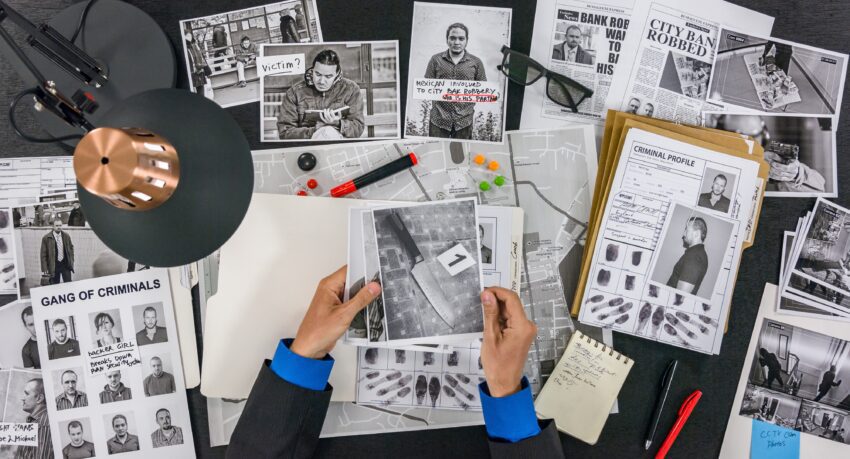
The Case File Approach: Ghostly Activities Revised Process
From time-to-time, Ghostly Activities reviews and revises ghost hunting processes, procedures and protocol based on experience from the field. Our goal is to simplify our investigation techniques and methods to make them more approachable for new ghost hunters. These reviews have led to … The Case File Approach. Get the scoop after the jump.
Listen To The Case File Approach
Table of contents
Our Ghost-To-Grave method worked well for intermediate-to-experienced investigators, but it was too complex for newbies. So, back to the drawing board we went to find a better process.
Here’s a professional-grade process and procedure set you can follow when solving a haunted mystery:
1. Define the Case
Start by treating each haunting as a case file.

Tasks:
- Write a concise case question: “Who haunts this place, and why?”
- Identify what’s known vs. unknown.
- Log initial claims (apparitions, sounds, feelings, etc.).
- Note who reported it, when, and under what conditions.
Deliverables:
A 1-page Case Intake Sheet (summary, claims, goals, date opened, leads to follow).
2. Conduct Historical Reconnaissance

This is your haunted history research phase, where your haunted mystery often begins to crack.
Tasks:
- Gather ownership records, census data, obituaries, crime reports, maps, and photos.
- Use local historical societies, archives, and newspaper databases.
- Cross-reference any deaths, accidents, or criminal events on-site or nearby.
- Create a chronology of major events for the location.
Deliverables:
A Timeline of Key Events and a Historical Context Sheet linking each to potential ghost activity.
3. Identify Patterns and Personas

Now look for patterns between haunting reports and historical data.
Tasks:
- Correlate activity times, locations, or sensory details.
- Match ghostly behavior to known personalities or emotional imprints from the past.
- Develop working theories (e.g., “Residual haunting from the 1910 fire victims.”)
Deliverables:
A Theory Matrix: a table listing each hypothesis, supporting evidence, and counterpoints.
4. Field Investigation

Now you apply your ghost-hunter skills to test those theories.
Tasks:
- Use baseline sweeps (EMF, temperature, infrasound, etc.).
- Set up multi-angle cameras, audio recorders, and data logs.
- Document everything meticulously — time stamps, environmental notes, reactions.
- Look for evidence that supports or disproves your historical theories.
Deliverables:
A Field Report with logs, photos, and audio/video summaries.
5. Evidence Analysis

You’re in your forensic phase now, the “ghost lab.”
Tasks:
- Review all data and tag anomalies.
- Check for correlations with time, place, and environmental factors.
- Rule out logical explanations first.
- Compare to prior investigations or witness accounts.
Deliverables:
An Evidence Table with classification (confirmed, inconclusive, debunked).
6. Cross-Verify with Witnesses and Experts

Revisit sources to confirm findings and interpretations.
Tasks:
- Interview descendants, property owners, or long-time locals.
- Consult subject-matter experts (historians, architects, crime archivists).
- Confirm your historical accuracy and emotional truth.
Deliverables:
An Interview Log and updated Case Summary.
7. Solve (or Theorize) the Mystery

Synthesize your findings into a narrative conclusion.
Tasks:
- Present the most plausible explanation, either ghostly or mundane.
- Include unanswered questions for transparency.
- Suggest next steps: further investigation, spiritual cleansing, or archival correction.
Deliverables:
A Case File Summary for your client or internal team.
8. Document & Publish the Report

Structure for publication:
- Hook — The haunting and why it matters.
- Background — Historical context and human story.
- Investigation — How you pursued the mystery.
- Evidence — What you found, what’s inconclusive.
- Theories — Logical vs. supernatural.
- Resolution — What’s next for the site or spirit.
It’s important to publish your work. This will lend credibility to your efforts while also helping other ghostly researchers. Quite frankly, if you don’t publish, you can’t call yourself a professional-level investigator.
We hope you use the Case File Approach framework to organize your ghost hunts. Feel free to adapt it to your specific needs. Let us know how you’ll use it in the comments below.
Thanks for reading Ghostly Activities. Much appreciated and take care!

One thought on “The Case File Approach: Ghostly Activities Revised Process”
Overall, I think this process (Case File Approach) will be the one I use to document our ghost hunts across Ghostly Activities. I won’t go back to retrofit older reports: It will start with new investigations.